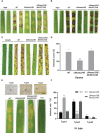The COPII subunit MoSec24B is involved in development, pathogenicity and autophagy in the rice blast fungus
- PMID: 36699840
- PMCID: PMC9868959
- DOI: 10.3389/fpls.2022.1074107
The COPII subunit MoSec24B is involved in development, pathogenicity and autophagy in the rice blast fungus
Abstract
The endoplasmic reticulum (ER) acts as the starting point of the secretory pathway, where approximately one-third of the proteins are correctly folded and modified, loaded into vesicles, and transported to the Golgi for further processing and modification. In this process, COPII vesicles are responsible for transporting cargo proteins from the ER to the Golgi. Here, we identified the inner shell subunit of COPII vesicles (MoSec24B) and explored the importance of MoSec24B in the rice blast fungus. The targeted disruption of MoSec24B led to decreased growth, reduced conidiation, restricted glycogen and lipids utilization, sensitivity to the cell wall and hypertonic stress, the failure of septin-mediated repolarization of appressorium, impaired appressorium turgor pressure, and decreased ability to infect, which resulted in reduced pathogenicity to the host plant. Furthermore, MoSec24B functions in the three mitogen-activated protein kinase (MAPK) signaling pathways by acting with MoMst50. Deletion of MoSec24B caused reduced lipidation of MoAtg8, accelerated degradation of exogenously introduced GFP-MoAtg8, and increased lipidation of MoAtg8 upon treatment with a late inhibitor of autophagy (BafA1), suggesting that MoSec24B regulates the fusion of late autophagosomes with vacuoles. Together, these results suggest that MoSec24B exerts a significant role in fungal development, the pathogenesis of filamentous fungi and autophagy.
Keywords: COPII; Magnaporthe oryzae; Sec24; autophagy; pathogenicity; signaling pathway.
Copyright © 2023 Qian, Sun, Wu, Zhao, Liu, Liang, Zhu, Li, Su, Lu, Lin and Liu.
Conflict of interest statement
The authors declare that the research was conducted in the absence of any commercial or financial relationships that could be construed as a potential conflict of interest.
Figures










Similar articles
-
MoOpy2 is essential for fungal development, pathogenicity, and autophagy in Magnaporthe oryzae.Environ Microbiol. 2022 Mar;24(3):1653-1671. doi: 10.1111/1462-2920.15949. Epub 2022 Mar 7. Environ Microbiol. 2022. PMID: 35229430
-
A Subunit of the COP9 Signalosome, MoCsn6, Is Involved in Fungal Development, Pathogenicity, and Autophagy in Rice Blast Fungus.Microbiol Spectr. 2022 Dec 21;10(6):e0202022. doi: 10.1128/spectrum.02020-22. Epub 2022 Nov 29. Microbiol Spectr. 2022. PMID: 36445131 Free PMC article.
-
The casein kinase MoYck1 regulates development, autophagy, and virulence in the rice blast fungus.Virulence. 2019 Dec;10(1):719-733. doi: 10.1080/21505594.2019.1649588. Virulence. 2019. PMID: 31392921 Free PMC article.
-
Investigating the cell and developmental biology of plant infection by the rice blast fungus Magnaporthe oryzae.Fungal Genet Biol. 2021 Sep;154:103562. doi: 10.1016/j.fgb.2021.103562. Epub 2021 Apr 18. Fungal Genet Biol. 2021. PMID: 33882359 Review.
-
Autophagy vitalizes the pathogenicity of pathogenic fungi.Autophagy. 2012 Oct;8(10):1415-25. doi: 10.4161/auto.21274. Epub 2012 Aug 30. Autophagy. 2012. PMID: 22935638 Review.
Cited by
-
Asymmetric distribution of mineral nutrients aggravates uneven fruit pigmentation driven by sunlight exposure in litchi.Planta. 2023 Oct 11;258(5):96. doi: 10.1007/s00425-023-04250-9. Planta. 2023. PMID: 37819558
-
A multilayered regulatory network mediated by protein phosphatase 4 controls carbon catabolite repression and de-repression in Magnaporthe oryzae.Commun Biol. 2025 Jan 28;8(1):130. doi: 10.1038/s42003-025-07581-3. Commun Biol. 2025. PMID: 39875495 Free PMC article.
References
LinkOut - more resources
Full Text Sources
Research Materials

